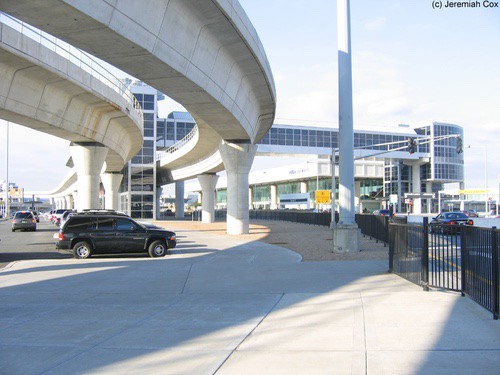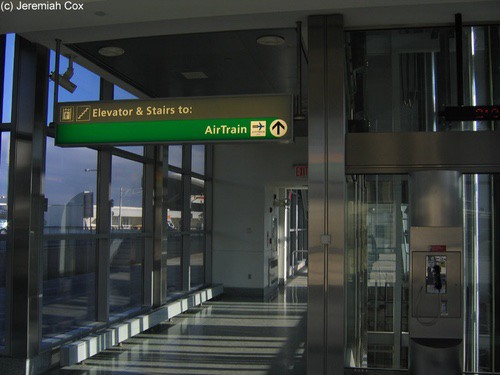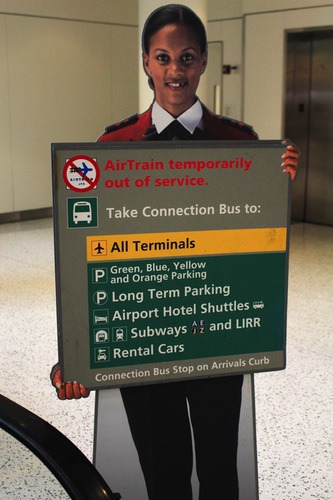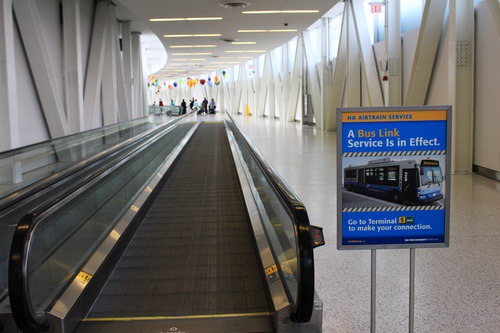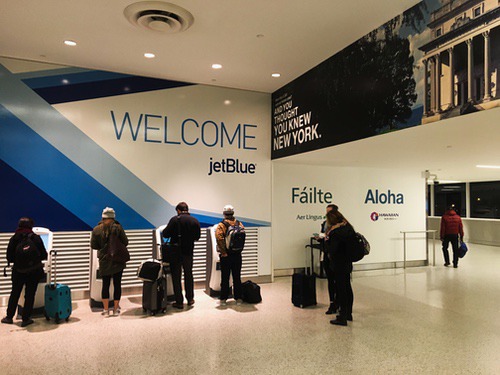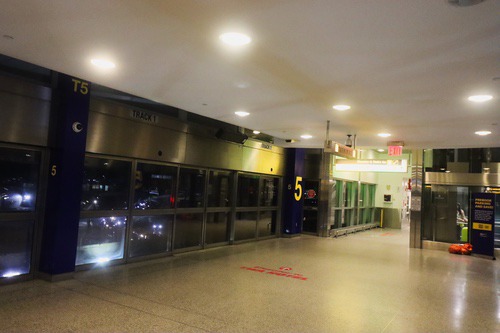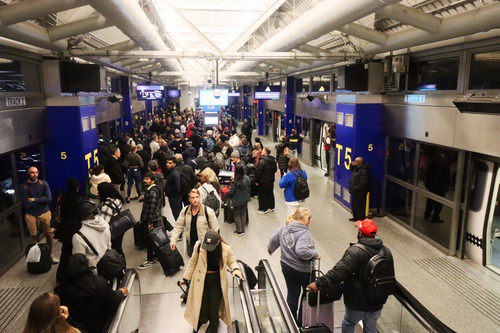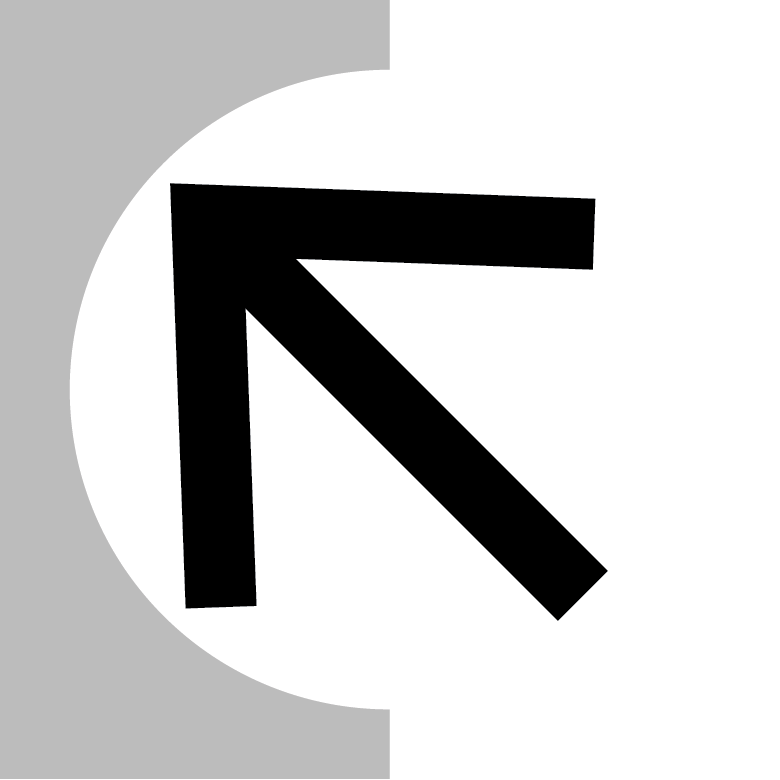


Terminal 5 opened as Terminals 5/6 although when it opened it only serviced the now demolished Terminal 6, with the station wasn’t originally built with a direct connection into the original Terminal 5. The station has pretty much exclusively serviced JetBlue and some of its airline partners (including new Terminal 6 is presently under construction and will most likely result in the station returning to its original name of Terminals 5 and 6. The original Terminal 5 is the landmarked Trans World Flight Center that opened in 1962 being ceased to operate as an airline terminal after the 2001 after the bankruptcy of Trans Word Airlines (and the absorption of its skeletal remains into American Airlines), before it was repurposed to become the lobby of the overpriced 1960s “retro-themed” TWA Hotel, which opened in 2019.
Instead, the station exclusively serviced Terminal 6 from the AirTrain’s opening in 2003 until 2008, when that terminal closed, and was replaced by the new Terminal 5 that surrounds the historic headhouse of the landmarked TWA Flight Center, although the original two gate areas accessible by iconic flight tubes were demolished. The AirTrain station itself has received no changes since it opened in 2003 with all of the terminal changes since it is was built alongside the Yellow Garage, across the street from the now demolished Terminal 6. The station consists of a single island platform for the two-track line, all access is from the southern (Terminal 4-bound end of the station). At this end of the platform an escalator provides access up a circular mezzanine along with elevators and a staircase beyond the end of the platform that provide access both up to the atrium and down to street level. The platforms are an intermediate landing for these elevators.
At street level today are signs (including red stickers on the floor) for the walkway (as of 2023 partially through a construction site) to the front door (at the original drop off area) to the TWA hotel. Along this walk (but after leaving the AirTrain station) there are multiple sandwich boards containing No Trespassing signs saying that the historic building is for hotel patrons only and not regular airport passengers. These signs strongly discourage travelers to the new Terminal 5 from going through the TWA hotel lobby and using the iconic flight tubes to reach their JetBlue Flights, instead of the SkyWalk. I violated these signs to visit the TWA Flight Center (while the AirTrain was having a meltdown due to an unattended bag) and my alibi was stating I was planning to buy something in the 1960s TWA themed gift shop if anyone questioned me.
The access to airplanes from this AirTrain station is by going up to one level above the platform. Here a short bridge with moving sidewalks leads across the terminal roadway to a bank of elevators (and stairs). These elevators are presently closed.
Originally this was where the bridge ended and this was area contained all access to Terminal 6 (with only elevators and stairs) via going outside. Terminal 6 was built by National Airlines and named the Sundrome. This building opened in 1969 and was designed by the architect I.M. Pei. It was a unique albeit more subdued architectural landmark than other terminals with all-glass mullions dividing the window sections, a super new construction technique in 1969. The terminal design was unique with the departures area and arrivals area separated, not by separate levels (as is the current standard for airport design), but on opposite sides of the same building Departures was directly outside this AirTrain station entrance. AirTrain Passengers took elevators down to street level and then were able to immediately enter the building. Arrivals and baggage claim (the terminal was always entirely domestic) was located on the opposite side of this building. Inside the building passengers went up a second level to fully enclosed connector bridges across the arrivals roadway before reaching the main terminal headhouse, where all airline gates were.
After the construction of Terminal 5, these elevators were put to use in a different way. They became the Central Terminal Area stop for MTA local buses (specifically the Q3, Q10 Local and Limited, and B15). These buses stopped at bus shelters at what was once the departures roadway for the now-demolished Terminal 6 Sundrome. This bus stop was closed on February 14, 2022 when most MTA bus service was kicked out of the Central Terminal Area due to construction of a new Terminal 6. The Lefferts Blvd AirTrain Station became the new JFK city bus terminal, where airline/airport employees and passengers must now needing to connect with the AirTrain. The Q3 bus still services Terminal 7 as an intermediate stop with buses now extended to Lefferts Blvd (replacing Q3 and Q10 service at the various hanger and airport building stops along the Van Wyck Service Road).
To reach airplanes today, passengers must use what JetBlue has named the Skywalk, an extension of the original bridge level, where multiple sets of moving sidewalks lead above the former arrivals roadway of Terminal 6 and gently curve around the roof of the T5i Extension that built a gate extension for an international arrivals area (opening in November 2014) to give terminal 5 (and all terminals at JFK Airport) international gates with US customs and immigration, and allowed JetBlue to no longer have to send arriving international flights from the Caribbean and Latin America to Terminal 4 before towing the planes back to Terminal 5 for departures. Signs say the walk takes 12 minutes. This walk ends at escalators, elevators and staircases down to the main JetBlue Check-in area, right near an elevator (the terminal was built also with a staircase connection – I used in 2015 during Open House New York) up to one of the original 1962 flight tubes into the TWA hotel.
Photos 1-4: January 9, 2005; 5-7: February 12, 2005; 8-11: October 11, 2014; 12: February 19, 2016; 13-47: October 24, 2023;
